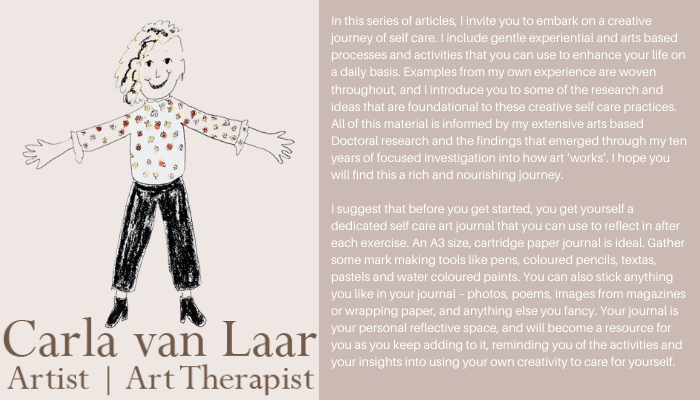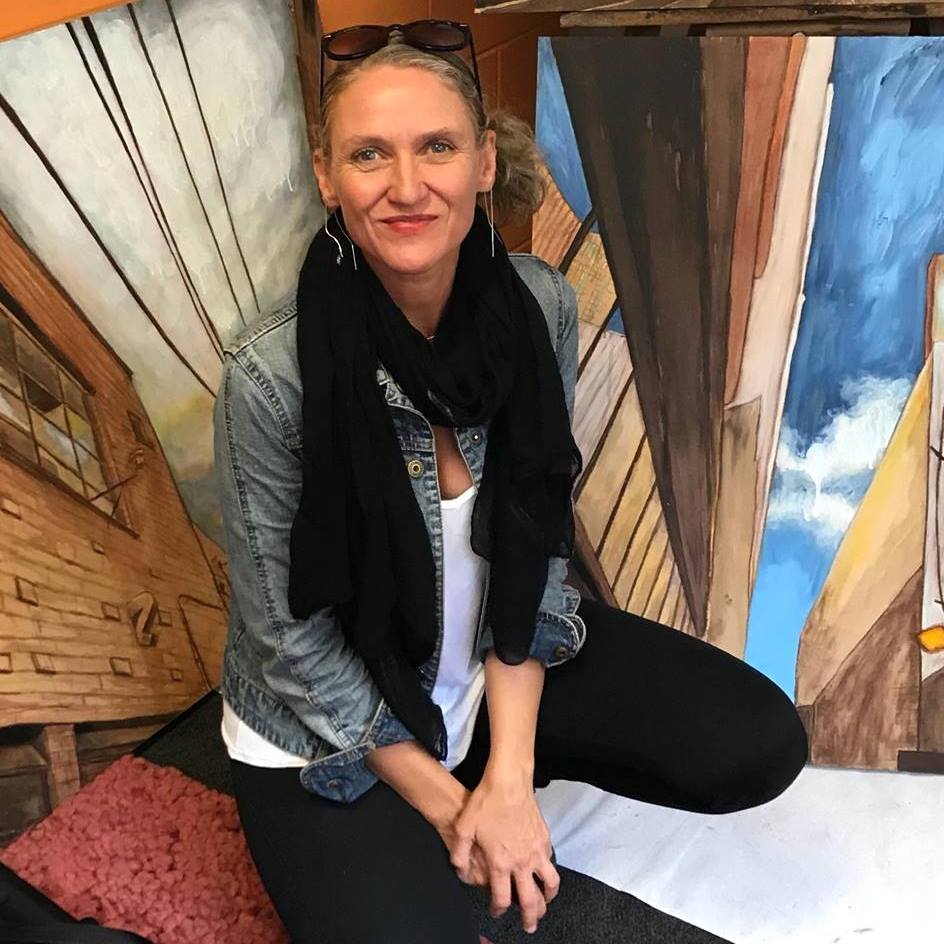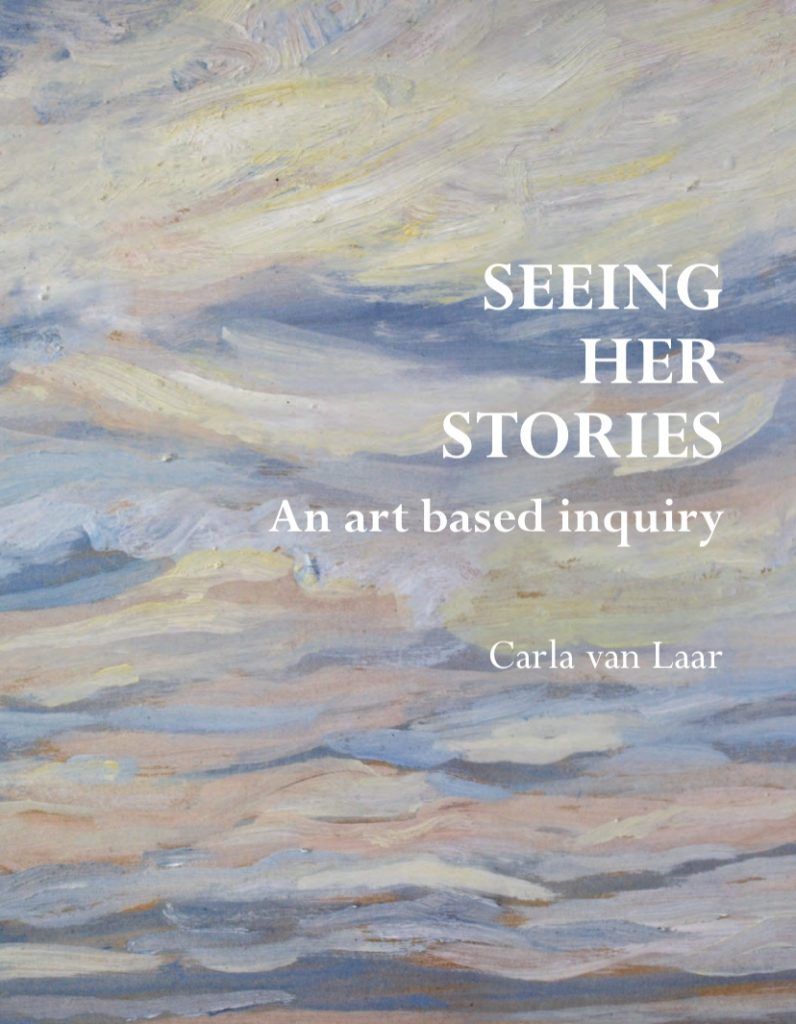With Dr Carla van Laar
Feature image credit Carla van Laar
In this article I introduce some ideas about change as an inevitable part of life, and invite you to observe the changes and choices you make through exploring an environment and working with the unconventional art materials of everyday life.

…
“Materials and moving – my choices today”
Life is full of changes.
In my Doctoral research, I investigated change and continuity as part of arts based practices. I wrote:
“In keeping with the classic Buddhist paradox, ‘Impermanence is here to stay’, change has been continuously present within this project from conception, and throughout the inquiry.
When used as a verb, the word ‘change’ can mean to make something different, to become different ourselves, or to exchange something for something else (change, n.d.). When used as a noun, the word ‘change’ describes the “act or process through which something becomes different” (change, n.d.). These meanings were reflected in my research narratives, and those of the participants. The word ‘continuity’ describes an “unbroken and consistent existence or operation of something over time” (continuity, n.d.).
…Changes in people’s behaviour, feeling states and physiology are frequently presented in art therapy, and generally in therapeutic literature, as evidence that the therapy is alleviating troubling symptoms and improving well-being (Allan, Barford, Horwood, Stevens & Tanti, 2015; Elkis-Abuhoff, Goldblatt, Gaydos & Convery, 2013; L. Morgan, Knight, Bagwash & Thompson, 2012; Patterson, Crawford, Ainsworth & Waller, 2011; Pounsett, Parker, Hawtin & Collins, 2006; Springham, Thorne & Brooker, 2014). In art therapy, this would typically involve the making of artwork and the artwork of clients being seen and responded to by the therapist and perhaps other group members. In this chapter, I show how our experiences of change within this research project differ from the dominant art therapy narratives about therapeutic change. In our descriptions, change is something to be observed and experienced, rather than as the necessary and desired end point of a therapeutic process.” (van Laar 2020)
If we can extend this perspective on change towards ourselves, we can meet ourselves with less judgement and more compassion.
Accepting that change is inevitable can be a hopeful and helpful viewpoint. If we practice simply noticing and accepting ourselves, we can begin to understand that we are always changing, and constantly making choices throughout our day in response to the changing circumstances we find ourselves in. It is this constant movement through life that we can become more aware of, and the choices we make every moment of every day to support our movement and growth. We don’t need to change – change just happens.
In the next exercise I invite you to pay attention to what draws your interest, what moves you, and the choices you make as you select materials.
The Process
I am inviting to choose a place, or an environment that you would like to explore. This might be your own home, the immediate outdoor area near where you live, the local supermarket, a park, or a place that you feel drawn to visit. It is your choice. Where do you feel like exploring today?
You might like to take along a piece of chalk, or charcoal.
When you have chosen your place and you are there, take a moment to be still, and look around.
I would like you to imagine that everything you see is a potential art material. Everything. Look around you and use your imagination to envisage what could be made with, or added to, or arranged around, or installed with the things you see. You might imagine building a sculpture out of your living room furniture. Or weaving found leaves and twigs to make a small nest. Or making a smiley face out of fruit at the shops. Or drawing strange creatures in chalk on the foot path. What else can you imagine? The whole world is your canvas.
Next, I would like to invite you to notice what is drawing your attention. What is calling you, willing you to come closer, look closer, be closer, even close enough to touch, to smell, to feel it? Let yourself be moved towards the things in your environment that interest you.
Start to work with them – being careful to do no harm. Let yourself play with these improvised art materials – whatever they are – objects in your home, organic matter you have found outdoors, produce in the grocery section or chalk drawings on concrete.
Keep going until you have made something and you are ready to stop. Take some steps back and observe your creation. Take a photo for your records.
Questions for reflective journaling
Notice the choices you make along the way.
What did you choose to move towards?
How did you choose to engage with it?
How did you begin to touch it?
How did you choose what to do with it?
How did you decide whether to keep going or when to stop?
Taking your reflections further
What other choices did you make along the way?
How do you move through life?
What have you noticed about the choices you make, and how you make them?
…
References
van Laar, C. Seeing Her Stories. Carlavanlaar.com, Brunswick, Australia.

Dr Carla van Laar
Artist | Art Therapist
Master of Creative Arts Therapy
Doctor of Therapeutic Arts Practice
Acreditted Supervisor and Clinical Registrant PACFA
Carla van Laar is a painter and therapeutic arts practitioner from Australia. Born in Brisbane, Carla is first generation Australian on her Dutch grandparents side, and 7th generation through her maternal bloodline who were mostly English and came to Australia in the early colonisation of the 1800s. Carla currently lives and works in Victoria, residing between Wurrundjeri country in Melbourne, and Boon Wurrung country in Inverloch, paying deep respects to the First Peoples of the Kulin Nations whose land was never ceded and will always be Aboriginal land. Identifying as a cisgender woman, Carla is passionately disinterested in socially constructed identities that disempower anyone. Carla has over 25 years’ experience working with people and the arts for health and well-being in community organisations, justice, health and education contexts.
Carla’s first book “Bereaved Mother’s Heart” was published in 2007 and broke social taboos about maternal grief. From 2008-18 she established and ran an independent art therapy studio and gallery in Melbourne. Her Doctoral research “Seeing Her Stories” continues the mission to make women’s stories visible, through art.
Carla has lectured and supervised Art Therapy students at RMIT, MIECAT and currently the IKON Institute. She is a practicing artist and in 2018 received an Artist Fellowship at RMIT’s creative research lab, “Creative Agency”. She insists on being part of a creative revolution in which art re-embodies lived experience, brings us to our senses, makes us aware of the interconnectedness of all life and is an agent of social change.
Carla’s new book “Seeing her stories” presents her research into making unseen stories visible through art, and is available to read for free online here or purchase a hard copy of the full colour hard cover coffee table book here.



Leave a Reply